


 |
 |
 |



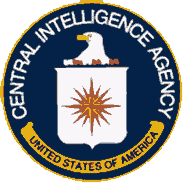

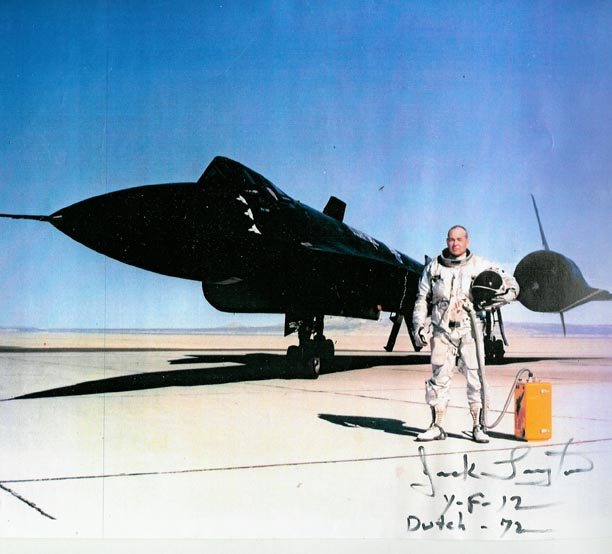
CIA A-12 CALL SIGN: DUTCH 27
AIR FORCE YF-12 CALL SIGN: DUTCH 72
 |
 |
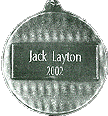
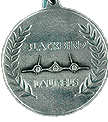
JACK LAYTON AND HIS FELLOW OXCART PILOTS DISPLAYING
BLACKBIRD LAURELS MEDALLIONS AFTER BEING INDUCTED INTO THE BLACKBIRD
LAURELS FRATERNITY, AN ELITE HONOR SOCIETY FOUNDED BY THE FLIGHT TEST
HISTORICAL FOUNDATION

Left to Right
Frank Murray, Dennis Sullivan, Ken Collins, Mele Vojvodich, Jack Layton
Missions flown by Jack Layton

![]()
CIA A-12 PILOTS RECEIVING CIA AWARDS AT THE CONCLUSION OF PROJECT OXCART
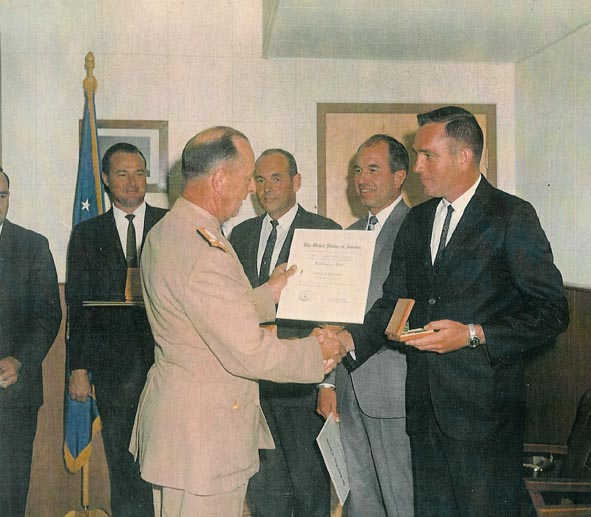
On 26 June 1968, the CIA Intelligence Star for Valor was awarded to CIA Oxcart and Black Shield mission Pilots (L to R): Mel Vojvodich, Dennis Sullivan, Jack Layton, Ken Collins, and Frank Murray by Deputy Director of the CIA VAdm Rufus Taylor. The posthumous award to Jack Weeks was accepted by his widow.
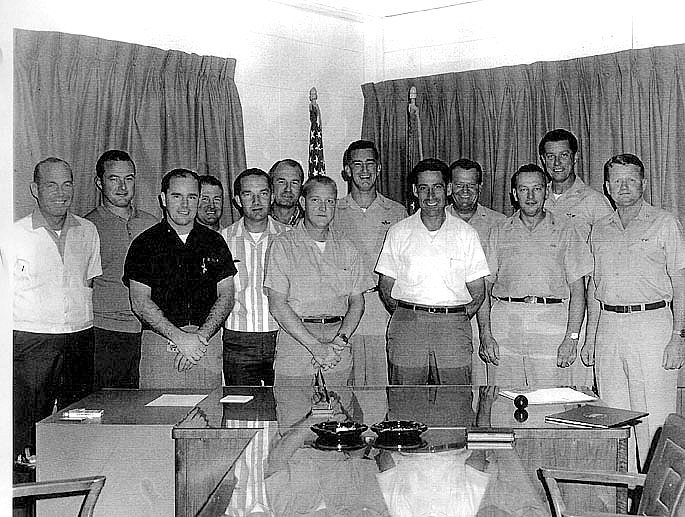
Agency Pilots and Groom Lake Brass Ronald J. Layton, Dennis Sullivan, Mele Vojvodich Jr., Burton S. Barrett, Jack Weeks, Kenneth Collins, Walter Ray, B. Gen. Jack Ledford (CIA Hq) William Skliar, Cy Perkins, Robert Holbury, John Kelly, Hugh (Slip) Slater
Col. Ronald "Jack" Layton, USAF ret., of Rexburg, Idaho. has
the unique distinction of seeing the sunset twice 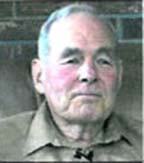 in the same day and the sun rise out of the west.
in the same day and the sun rise out of the west.
Jack was born and raised in the White Mountains region of
Arizona. His interest in aviation began at a very young age. "I grew
up in a wilderness area of the White Mountains, and back when I was young
I would see an airplane fly over once or twice a month at very high
altitude, and it just fascinated me, and that feeling never left. About
age eight I had my first ride in a low wing Fairchild in a town called
Eager, Arizona. I don't recall the exact designation, but that started an
itch that I just had to scratch."
 Born
in 1927 and too young for military service during WWII, Jack enlisted in
the U.S. Air Force Aviation Cadets program in 1950 in order to learn to
fly. "It always intrigued me and it was something I wanted to do in
the worst way, and I did it and fortunately made it. In my basic training
we graduated only 46 out of 142, so I felt like I had one leg in and one
leg out all the way through."
Born
in 1927 and too young for military service during WWII, Jack enlisted in
the U.S. Air Force Aviation Cadets program in 1950 in order to learn to
fly. "It always intrigued me and it was something I wanted to do in
the worst way, and I did it and fortunately made it. In my basic training
we graduated only 46 out of 142, so I felt like I had one leg in and one
leg out all the way through."
After earning his silver wings, Jack was assigned to the 79th Fighter
Squadron of the 20th Tactical Fighter Wing, and it was not long before
Jack was forced to bail out of an airplane, the first of three emergency
bailouts over his career. Just a few months after graduation the C-47 Jack
was riding in caught fire while flying over the Everglades of Florida.
"I had to jump out the back door. It was one o'clock in the morning
and we went into the Everglade swamps. I was from Arizona and I didn't
know a thing about swamps - I thought for sure I'd be up to my armpits in
cottonmouths and alligators. We got picked up the next afternoon, so I was
in there for about twelve hours. I saw one alligator and no snakes, but I kept a big stick handy to beat the water and the grass
there just in case."
After his "adventure" in the swamp, Jack spent the next eight
years or so flying Republic F-84s at Shaw AFB in South Carolina, Langley
AFB in Virginia, and Woodbridge AFB in England. He then flew North
American F-89s and McDonnell F-101s at Hamilton AFB in California. It was
during this time that Jack had his second bailout. "I had to eject
from an F-101B out over the Gulf of Mexico flying out from Panama City. I
spent the night in the water out there and was picked up by the Coast
Guard."
For some military pilots, two emergency bailouts over a career would be
exciting enough, but for Jack the excitement was just beginning. In the
early 1960s, he was selected for screening to join a top secret CIA
program called Project Oxcart. Project Oxcart was developed after a
perceived need to replace the Lockheed U-2 reconnaissance airplane. The
U-2 dated from as far back as 1952, when development on the aircraft began
under the direction of a CIA initiative headed by Richard M. Bissell.
Within just a few years of U-2 operational flights over the Soviet Union,
CIA officials found that a replacement was needed, one that could fly
higher and much faster. A very competitive race between Convair and
Lockheed erupted to design the U-2's replacement. By 1960 Lockheed was
given the green light to produce Kelly Johnson's radical new design,
designated the Archangel 11, or A-11. This was later changed to A-12 when
the aircraft underwent structural changes to decrease its radar signature.
The A-12 was highly advanced for its time, designed to cruise at three
times the speed of sound at over 90,000 feet.
Pilots for the Oxcart Project had to meet a very demanding set of CIA and
Air Force specifications. Air Force files were screened for possible
candidates that were qualified in the newest high performance jet
fighters, emotionally stable, and extremely well motivated. They had to be
between 25 and 40 years of age, less than six feet tall, and weigh no more
than 175 pounds. By November of 1961 the initial five pilots were
selected, and by February 1963 another eleven were picked by the Agency.
Jack was in the second group. He was sent to Groom Lake, Nevada, better
known as Area 51, for intensive flight-testing of the new airplane.
"I was brought in very early on the A-12 program," Jack
explains, "the A-12 being the forerunner of the SR-71 Blackbird. We
tested it for a little over four years before we were operationally ready.
In the early days one of the biggest problems we had to overcome was
the inlet control system - you had the big spikes that stuck out of the
front of the engine nacelles and as you got up to near Mach 2.5 they start
modulating back into the nacelle along with about 10,000 other little
things going on with it to keep the supersonic shockwaves within the
nacelle. In the early days we would as we called it, 'pop the shock.' The
technical term is to unstart the inlet. It was like six sticks of dynamite
going off and all of a sudden you're flying half sideways and it would get
a little hairy at times. I've had some flights where that happened as many
as fifteen or sixteen times, and others where it didn't happen at all.
That was always an exciting period of time, flying that fast and that
high. It cruised at Mach 3.2, but it took us the better part of a year
before we got it out to 3.2, mainly because of the inlet system. Going so
fast was one heck of a big thrill!"
Flying over three times the speed of sound presented some unique
opportunities to the Oxcart pilots. "I was flying a mission out of
Groom Lake in an A-12, and I flew to a point about 380 miles east of St.
Louis, Missouri and made a 180 degree turn and flew back. We got off to
quite a late start due to some maintenance delays; the sun was already low
in the sky. On the way out just before I made the turn it started getting
dark very rapidly because I was outrunning the sun by quite a bit. Before
I completed the turn it was pitch black. On the way back at about Denver,
Colorado the sun popped back up in the sky on the western horizon. As you
know, the sun normally rises in the east. It didn't take me very long to
get back to Groom Lake and before long the sun had set again."
"At the time the significance of it didn't even really enter my mind
until we were talking about it late that evening. I was doing pretty close
to 2,200 mph, and I figure I was outrunning the sun by about 1,200 mph. At
the time it was shining right straight in on my face and the faceplate on
my pressure suit and I got a horrendous reflection. The effect was like a
mirror, all I could see was my own face looking back at me and each
whisker looked like a tree stump as I was trying to see through to the
instrument panel. It was really quite an irritation, but later on we
decided it was really quite a significant event."
By 1966 the A-12 was ready for operations, but it would be some time
before actual missions were flown. During those same years the A-12 was
being test flown, development of the SR-71 reconnaissance plane and YF-12
interceptor 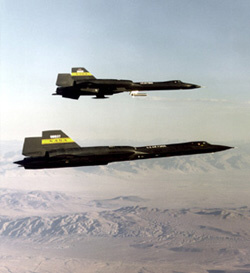 were well underway. While the A-12 was a CIA aircraft flown by Air Force
pilots under contract with the CIA, the SR-71 was a less sophisticated
airplane than the A-12, but with the same reconnaissance mission, only
under Air Force control. The YF-12 was developed as a missile-carrying
interceptor for the Air Defense Command of the Air Force, but only two
prototypes were completed and no orders were made. Jack had the
opportunity to fly all three aircraft over his career.
were well underway. While the A-12 was a CIA aircraft flown by Air Force
pilots under contract with the CIA, the SR-71 was a less sophisticated
airplane than the A-12, but with the same reconnaissance mission, only
under Air Force control. The YF-12 was developed as a missile-carrying
interceptor for the Air Defense Command of the Air Force, but only two
prototypes were completed and no orders were made. Jack had the
opportunity to fly all three aircraft over his career.
"The SR-71 was a reconnaissance aircraft, as was the A-12. The YF-12
interceptor had a more rounded nose to house a large radar. It had better
instrumentation than the SR-71, which unfortunately most of the pilots
voted down in the beginning. We had a chance to have the same
instrumentation in the SR-71, but that was voted down. It was a mistake,
but that was because of ignorance. The vertical style instruments are much
superior in my opinion than the round gages, but the majority ruled."
In May 1967 Jack was selected to fly one of three of the twelve A-12s
manufactured by Lockheed to Kadena airfield at Okinawa for Project Black
Shield. Project Black Shield had a number of purposes, foremost being
reconnaissance flights over Southeast Asia, North Korea, and the Soviet
Union. A secondary purpose was the permanent establishment of an Air Force
base on Okinawa. The rest of that year was spent flying missions over
North Vietnam. A year later, Jack flew the last known mission ever flown
by an A-12 on May 8, 1968. "We were flying out of Kadena. The last
mission of the A-12 was flying over Wonsan Harbor looking for the Navy
ship USS Pueblo that the North Koreans had captured earlier that year.
That was the last operational mission of the A-12."
Jack returned to the U.S. and on June 26, 1968 was awarded the CIA
"Intelligence Star for Valor" for his service during the Black
Shield project. Jack spent the next three years flight-testing SR-71s and
the two YF-12s, which had been turned over to NASA for testing at Edwards
AFB. Jack spent six months flying the NASA planes, and it was during this
time that he experienced his third emergency bailout. "In June of
1971 while flying a regular mission for NASA I had a bad explosion in the
right engine nacelle. The right engine caught fire and burned fiercely,
and I couldn't get the fire out. In just a few minutes I lost my hydraulic
pressure, which I needed to control the airplane, so my radar operator
Billy Curtis and I had to eject out of there."
Both Jack and Billy escaped the incident with minor injuries. He kept
flying for the next couple of years, but by December of 1974 Jack had had
enough excitement and decided it was time to retire from the Air Force.
"I told my wife, 'Sweetie, no matter what happens from here on out it
will be anticlimactic.' And it was."
Under its research agreement with NASA, the Air Force provided the agency
with two YF-12A aircraft in 1969. On June 24,  1971, one of the planes (serial no. 60-6936) experienced an inflight fuel
line failure and engine fire. Unable to save the smoking aircraft, Air
Force pilot Lt. Col. Ronald Layton and systems engineer Major Billy A.
Curtis ejected and were not injured, but the YF-12A was lost in a fiery
explosion in the desert. About this time, Dryden acquired a so-called
YF-12C, which was in fact a then-secret SR-71A (serial no. 61-7951) given
the NASA tail no. 60-6937. The reason for this bit for subterfuge lay in
the fact that NASA, while flying the YF-12A interceptor version of the
aircraft, was not allowed to
possess the strategic reconnaissance version for some time. The bogus tail
number actually belonged to a Lockheed A-12 (serial no. 60-6937), but the
existence of the A-12 remained classified until 1982. The tail number
06937 was selected because it followed in the sequence of tail numbers
assigned to the three existing YF-12A aircraft: 06934, 06935, and 06936.
1971, one of the planes (serial no. 60-6936) experienced an inflight fuel
line failure and engine fire. Unable to save the smoking aircraft, Air
Force pilot Lt. Col. Ronald Layton and systems engineer Major Billy A.
Curtis ejected and were not injured, but the YF-12A was lost in a fiery
explosion in the desert. About this time, Dryden acquired a so-called
YF-12C, which was in fact a then-secret SR-71A (serial no. 61-7951) given
the NASA tail no. 60-6937. The reason for this bit for subterfuge lay in
the fact that NASA, while flying the YF-12A interceptor version of the
aircraft, was not allowed to
possess the strategic reconnaissance version for some time. The bogus tail
number actually belonged to a Lockheed A-12 (serial no. 60-6937), but the
existence of the A-12 remained classified until 1982. The tail number
06937 was selected because it followed in the sequence of tail numbers
assigned to the three existing YF-12A aircraft: 06934, 06935, and 06936.
The SR-71 differed from the YF-12A in that the YF-12A had a round nose
while the SR-71 had its chine carried forward to the nose of the airplane.
There were other differences in internal and external configuration, but
the two aircraft shared common inlet designs, structural concepts, and
subsystems.
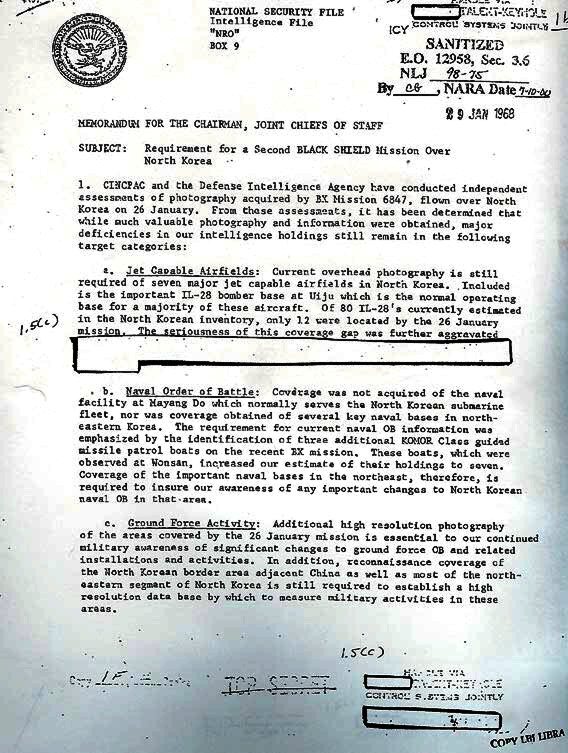
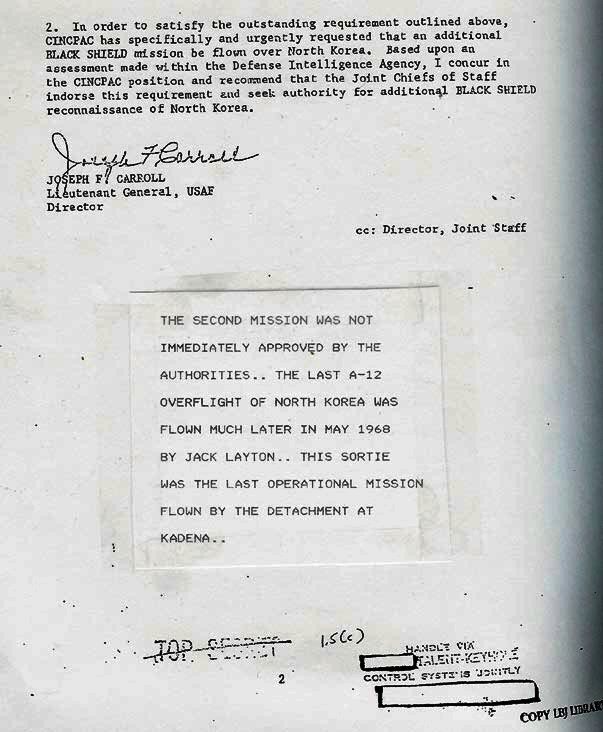
CIA 60TH ANNIVERSARY - 19 September 2007
A-12 Project Pilot Jack Layton attending A-12 Article 128 Dedication
Layton Family Photos
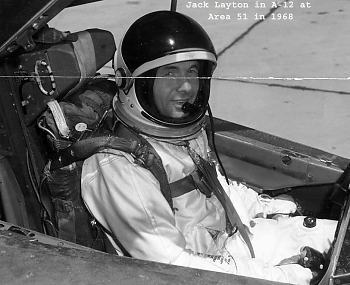 It is with great sadness that I must inform the CIA, Air Force, and aviation families of the final flight of Colonel Ronald "Jack" Layton, CIA A-12 call sign: DUTCH 27 and Air Force YF-12 call sign: DUTCH 72.
It is with great sadness that I must inform the CIA, Air Force, and aviation families of the final flight of Colonel Ronald "Jack" Layton, CIA A-12 call sign: DUTCH 27 and Air Force YF-12 call sign: DUTCH 72.
Jack was born and raised in the White Mountains region of Arizona. His interest in aviation began at age eight when he took his first ride in a low wing Fairchild in a town called Eager, Arizona.
Born in 1927 and too young for military service during WWII, Jack enlisted in the U.S. Air Force Aviation Cadets program in 1950 to learn to fly. After earning his silver wings, Jack was assigned to the 79th Fighter Squadron of the 20th Tactical Fighter Wing where he was forced to bail out of an airplane, the first of three emergency bailouts over his career. Just a few months after graduation the C-47 Jack was riding in caught fire while flying over the Everglades of Florida where he spent the night with cottonmouths and alligators. Jack spent the next eight years or so flying Republic F-84s at Shaw AFB in South Carolina, Langley AFB in Virginia, and Woodbridge AFB in England. He then flew North American F-89s and McDonnell F-101s at Hamilton AFB in California. It was during this time that Jack had his second bailout when he ejected from an F-101B out over the Gulf of Mexico flying out from Panama City. He spent the night in the water before being picked up by the Coast Guard. In the early 1960s, the CIA selected Jack for the top secret CIA A-12 Project Oxcart at the agency's Groom Lake facility commonly referred to as Area 51. (The CIA A-12 preceded the Air Force's SR-71 Blackbird.) The CIA sheep dipped Jack from the Air Force where flying over three times the speed of sound , he enjoyed the unique distinction of seeing the sunset twice in the same day and the sun rise out of the west while flying an A-12 mission out of Groom Lake. About 380 miles east of St. Louis, Missouri he was outrunning the sun when he made a 180 degree in darkness. On the way back at about Denver, Colorado at about 2200 mph, the sun popped back up in the sky on the western horizon. He arrived back at Groom Lake in time to watch the sun set again. In May 1967 while stationed at Groom Lake, Jack rotated to Kadena airfield to fly A-12s Operation Black Shield reconnaissance flights over Southeast Asia. A year later, Jack flew the last known mission ever flown by an A-12 on May 8, 1968 over Wonsan Harbor in North Korea looking for the Navy ship USS Pueblo that the North Koreans had captured earlier that year. That was the last operational mission of the A-12." Jack returned to the U.S. and on June 26, 1968 was awarded the CIA "Intelligence Star for Valor" for his service during the Black Shield project. Jack spent the next three years flight-testing SR-71s and the two NASA YF-12 Blackbirds where he experienced his third emergency bailout in June of 1971 when a bad explosion in the right engine nacelle caught the engine on fire. Ironically, this was the day he made colonel. Besides his earning the CIA Intelligence Star for Valor and numerous Air Force awards, Colonel Layton was inducted into the Blackbird Laurels Fraternity, an elite honor society founded by the Flight Test Historical Foundation. Colonel Layton was a member of Roadrunners Internationale. He is survived by his spouse, Eunice, daughter Karen Stone, 8 grandchildren, and 18 grandchildren. Jack is preceded in death by children Janice Marie and Larry Graham Layton. In behalf of the Roadrunners, I extend our condolences to the family.
Visitation will be Friday evening, 17 May and service the 18th at 1:00 pm at the Flamm Funeral Home, 61 North 1st East, Rexburg, ID 83440; Phone: 208 356-5721
We will miss you, Jack.
Ronald (Jack) Layton, Colonel USAF Retired passed away Tuesday, May 14 2013. Jack Layton was also known as Dutch 27, one of the few men that flew the A-12 operationally for the CIA during the Operation BlackShield days.
Jack Layton was an old friend of mine. He was my Instructor on a couple different airplanes over the years. He was a very "cool" Instructor, not too picky but very thorough. I digress:
Way back in 1957, I was one of the new guys sent to the 27th Fighter Bomber Wing at Bergstrom AFB. This assignment was my lucky day since the Fighter Wing I had been in was deactivated and I was fortunate to be assigned to one of the Squadrons that were just equipped with the new F-101A Fighter Bomber.
When I checked in with the 524th Fighter Bomber Squadron, I was assigned to a Flight for training. Part of that training was my attendance at the Flight Simulator Section for learning the cockpit setup, basic systems operation etc.......My assigned Instructor was none other than Capt. Jack Layton. First time I had met this guy, he was very experienced in airplanes I had flown and was the authority I learned to know on the F-101A. He also was my flight Instructor, flying chase in another F-101A
About six years later I was assigned to the 1129th Special Activities Squadron at Groom Lake.. Guess what? Ran into Jack Layton again, this time, he was one of the select few that had been taken from the Air Force to form the pilot pool to fly the newest, fastest, reconnaisance airplane in the world.
My assignment to the 1129th was to be a chase pilot on the Project. A few years into that assignment, I was invited to become one of the few Project pilots to fly the A-12.. Guess what again? Jack Layton was once again my Instructor pilot for A-12 training. Small world!
We flew together on the OXCART Project, also flew together a lot with the F-101Bs that were the chase airplanes there.
Over the years since OXCART, the Laytons and my gang have celebrated the good old days at Reunions and family visits.
Rest in Peace Old Friend. Frank Murray Dutch 20
 |
 |
 |